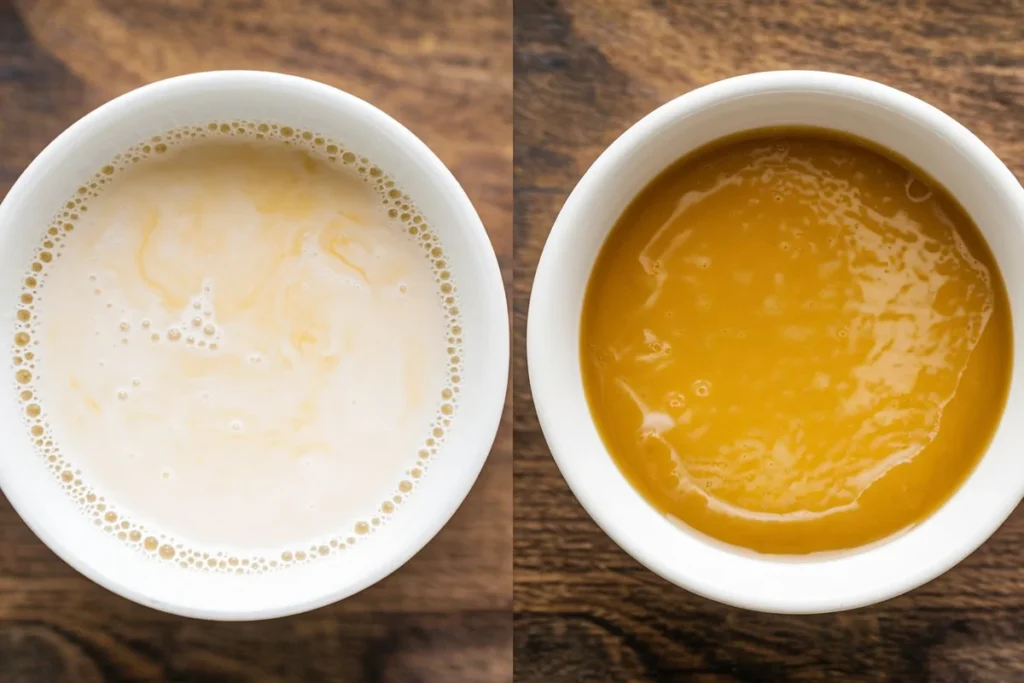Pumpkin pie is an iconic dessert, especially during fall and Thanksgiving celebrations. But a common debate among home bakers and professional chefs alike is: Is it better to use condensed milk or evaporated milk in pumpkin pie? The choice between these two ingredients significantly affects the pie’s flavor, texture, and overall experience.
Some recipes call for evaporated milk, which gives the pie a light, custard-like texture, while others use sweetened condensed milk, which results in a denser, creamier, and sweeter pie. But which one is truly better for the perfect pumpkin pie? This article will explore both options in detail, breaking down their differences, how they affect the final product, and which one you should choose depending on your preferences.
Table of Contents
What is Evaporated Milk?
Evaporated milk is a shelf-stable dairy product that has undergone a gentle heating process to remove approximately 60% of its water content. This results in a concentrated, creamy liquid with a slightly thicker consistency than regular milk, but not as thick as sweetened condensed milk.
Unlike sweetened condensed milk, evaporated milk contains no added sugar, making it a versatile ingredient in both sweet and savory dishes. The heating process also gives it a lightly caramelized flavor, which enhances the depth of taste in recipes. Due to its long shelf life, it is a convenient pantry staple for cooking and baking.
How is Evaporated Milk Made?
The production of evaporated milk involves:
- Heating fresh milk to evaporate about 60% of its water content.
- Homogenizing the milk to ensure a smooth, consistent texture.
- Canning and sterilizing the milk, which extends its shelf life and prevents spoilage.
- Cooling and packaging the milk for distribution.
This process gives evaporated milk its slightly thicker consistency and subtle caramel notes while retaining most of the nutrients found in fresh milk.
Nutritional Benefits of Evaporated Milk
Compared to regular milk, evaporated milk offers several nutritional advantages, including:
- Higher calcium and protein content per serving due to water reduction.
- Less lactose than fresh milk, making it easier to digest for some individuals.
- No added sugar, making it a healthier choice for controlled diets.
- Good source of vitamins A and D, essential for bone health and immunity.
Key Characteristics of Evaporated Milk
- No added sugar – allows bakers to control sweetness in recipes.
- Slightly caramelized taste – enhances depth of flavor in baked goods and sauces.
- Light and custard-like texture – makes pies and custards smoother.
- Versatile in cooking and baking – works well in both sweet and savory dishes.
Common Uses of Evaporated Milk in Baking
Evaporated milk is a staple ingredient in many classic recipes due to its ability to enhance texture and flavor. It is frequently used in:
1. Pumpkin Pie Recipes
One of the most popular uses of evaporated milk is in pumpkin pie, where it creates a silky-smooth custard filling. Since evaporated milk lacks added sugar, it allows the natural flavors of pumpkin and spices to shine without making the pie overly sweet.
2. Custards and Puddings
- Improves the creaminess of custards, flans, and puddings.
- Adds richness without excess fat, unlike heavy cream.
3. Creamy Soups and Sauces
- Used as a lower-fat alternative to heavy cream in soups like creamy tomato soup and corn chowder.
- Enhances the thickness and silkiness of sauces without adding extra sugar.
4. Mac and Cheese & Casseroles
- Provides a velvety smooth texture without making the dish overly heavy.
- Helps cheese melt evenly and prevents curdling.
5. Breads and Cakes
- Used in yeast breads, rolls, and cakes to create a soft, tender crumb.
- Adds moisture and richness to recipes like tres leches cake and pound cake.
Why Bakers Prefer Evaporated Milk for Pumpkin Pie
For those who enjoy a traditional pumpkin pie with a smooth, custard-like texture, evaporated milk is the preferred choice because:
- It creates a light and airy filling instead of a dense, overly rich one.
- It allows for more control over sweetness since sugar is added separately.
- The natural pumpkin and spice flavors are not overpowered by excessive sweetness.
Overall, evaporated milk is an essential ingredient for bakers looking to achieve a perfectly balanced, classic pumpkin pie that is not too sweet or too heavy.
What is Sweetened Condensed Milk?
Sweetened condensed milk is a thick, creamy, and highly concentrated dairy product made by removing about 60% of the water from regular milk and then adding a significant amount of sugar. This results in a dense, syrup-like texture that is much sweeter and richer than regular milk or evaporated milk.
Unlike evaporated milk, which is unsweetened, sweetened condensed milk contains approximately 40-45% sugar by weight, making it an integral ingredient in desserts, candies, and rich beverages. The combination of milk and sugar creates a smooth, velvety consistency, making it an excellent binding agent for custards, pies, and caramel-based desserts.
How is Sweetened Condensed Milk Made?
The production process involves several steps to achieve its thick and luscious consistency:
- Evaporation: Fresh milk is gently heated to remove about 60% of its water content.
- Sugar Addition: Large amounts of sugar are added, preventing bacterial growth and extending shelf life.
- Homogenization: The milk is processed to ensure a smooth, uniform consistency.
- Canning and Sterilization: The final product is sealed in airtight cans, making it shelf-stable for years.
Nutritional Profile of Sweetened Condensed Milk
While sweetened condensed milk is a delicious ingredient, it is higher in sugar and calories than regular milk or evaporated milk.
Per two tablespoons (30g):
- Calories: ~120
- Carbohydrates: ~20g (mostly from sugar)
- Protein: ~3g
- Fat: ~3-4g
- Calcium: ~8-10% of the daily recommended intake
Since sweetened condensed milk is very high in sugar, recipes using it rarely require additional sweeteners.
Key Characteristics of Sweetened Condensed Milk
- Contains added sugar – makes it significantly sweeter than evaporated milk.
- Thick and syrupy – contributes to dense, creamy, and smooth desserts.
- Enhances richness – results in a more pronounced dairy flavor compared to evaporated milk.
- Shelf-stable – does not require refrigeration until opened.
Common Uses of Sweetened Condensed Milk in Baking
Due to its high sugar content and thick consistency, sweetened condensed milk is a key ingredient in many rich desserts.
1. Pumpkin Pie Recipes (for a Richer, Denser Filling)
Using sweetened condensed milk in pumpkin pie results in a more decadent, dessert-like experience. Because of its natural sweetness, no extra sugar is needed, making it an easy, one-step addition.
2. Caramel and Dulce de Leche Recipes
- Sweetened condensed milk is often heated slowly to create caramel or dulce de leche.
- The Maillard reaction gives it a deep golden-brown color and intense caramelized flavor.
- Used in caramel flan, tres leches cake, and banoffee pie.
3. Fudge and Candy-Making
- Acts as a binding and sweetening agent in fudge, truffles, and toffee.
- Helps create chewy, creamy textures without the need for extra butter or cream.
4. Creamy Beverages (Thai Iced Tea, Vietnamese Coffee, Horchata)
- Adds richness and sweetness to drinks without additional sugar.
- Used in Vietnamese iced coffee for a thick, luxurious mouthfeel.
- Essential in bubble teas and tropical beverages.
Why Some Bakers Prefer Sweetened Condensed Milk for Pumpkin Pie
For those who prefer a thicker, more dessert-like pumpkin pie, sweetened condensed milk is the ideal choice because:
- It eliminates the need for added sugar, simplifying the recipe.
- It creates a denser, silkier filling compared to evaporated milk.
- It intensifies the sweetness and richness of the pie.
However, because sweetened condensed milk already contains sugar, bakers cannot easily adjust the sweetness level. This makes it less flexible for those who prefer a less sweet pie or want to balance the pumpkin flavor with spices rather than sugar.
Is it Better to Use Condensed Milk or Evaporated Milk in Pumpkin Pie?
The difference between these two ingredients significantly affects the outcome of the pumpkin pie. Below is a side-by-side comparison of how they impact the final product.

| Feature | Evaporated Milk | Sweetened Condensed Milk |
|---|---|---|
| Sweetness | Needs added sugar | Naturally sweet due to added sugar |
| Texture | Light, custard-like | Dense, creamy |
| Flavor | Milder dairy taste with caramel notes | Richer, more pronounced sweetness |
| Baking Adjustments | Requires additional sugar | No extra sugar needed |
| Best for | Traditional pumpkin pies | Extra creamy, sweet pies |
How the Choice of Milk Affects Pumpkin Pie
1. Sweetness and Flavor Balance
Using sweetened condensed milk results in a much sweeter pie because of the added sugar. This is ideal for those who prefer a richer, dessert-like experience. However, if you enjoy a more balanced, lightly sweetened pie that lets the pumpkin and spices shine, evaporated milk is the better choice.
2. Texture and Consistency
- Evaporated milk leads to a smooth, light, and slightly airy texture, closer to a custard.
- Sweetened condensed milk makes the filling thicker and silkier, with a more dense and luscious mouthfeel.
3. Adjusting Recipes Based on Your Choice
If using evaporated milk, you will need to add sugar separately and balance the flavors accordingly. If using sweetened condensed milk, omit any additional sugar from your recipe.
How to Make Pumpkin Pie with Evaporated Milk
If you want a classic, traditional pumpkin pie, evaporated milk is the way to go.

Ingredients
- 1 can (15 oz) pumpkin puree
- 3/4 cup sugar
- 1 tsp cinnamon
- 1/2 tsp ginger
- 1/4 tsp cloves
- 1/2 tsp salt
- 2 eggs
- 1 can (12 oz) evaporated milk
- 1 unbaked pie crust
Instructions
- Preheat the oven to 425°F (220°C).
- In a bowl, whisk together pumpkin, sugar, and spices.
- Beat in eggs, then stir in evaporated milk.
- Pour the mixture into the pie crust.
- Bake for 15 minutes, then reduce the temperature to 350°F (175°C) and bake for another 40-50 minutes until set.
- Cool completely before serving.
You can also check this link if you would like a pumpkin pie recipe with condensed milk. If you are looking for a drink to pair up with this delicious pumpkin pie, this perfect fall lemonade recipe is made for you.
Which One Should You Choose?
- For a classic, less sweet pie → Use evaporated milk
- For a sweeter, denser pie → Use sweetened condensed milk
- For experimenting → Try both and decide based on your taste preference!
FAQs – Is it Better to Use Condensed Milk or Evaporated Milk in Pumpkin Pie?
Q: Can I substitute sweetened condensed milk for evaporated milk in pumpkin pie?
A: Not directly! Since sweetened condensed milk has added sugar, you would need to adjust the sugar content in your recipe.
Q: Does using sweetened condensed milk make the pie too sweet?
A: Yes, it does create a sweeter pie. If you prefer a balanced taste, consider using evaporated milk.
Q: Can I use heavy cream instead of evaporated or condensed milk?
A: Yes, heavy cream can be used, but it will result in a much richer, heavier pie.
Q: Are there dairy-free alternatives?
A: Yes! You can use coconut milk, almond milk, or oat milk, though the texture and flavor may change.
Q: Which option lasts longer?
A: Both options last about 3-4 days in the refrigerator. Store your pie covered for the best freshness.
Final Verdict – Is it Better to Use Condensed Milk or Evaporated Milk in Pumpkin Pie?
Both evaporated milk and sweetened condensed milk can make delicious pumpkin pies, but the choice depends on your desired texture, sweetness level, and preference. If you love a traditional, light pie, go with evaporated milk. If you want a rich, indulgent dessert, opt for sweetened condensed milk. You can also try one of this delicious cherry cheesecake recipe or this best hot chocolate cookie if you are craving other sweets.
Which one do you prefer? Let us know in the comments! 🥧

